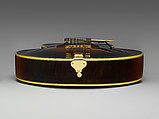Archtop Guitar
John D'Angelico American
John D’Angelico was one of the most important guitar makers in the United States. The son of Italian immigrant parents, he spent his entire career on the Lower East Side of Manhattan building instruments, especially archtop guitars—guitars with carved arched tops and backs like on a violin—that were especially valued by jazz players for their percussive sound and ability to be heard in a big band. This guitar bears his second serial number and is indicative of his early period when his instruments were patterned after the Gibson Company's L-5 model guitars. This example was bought by the guitarist Benny Mortel who played it with the Buddy Rogers Orchestra. It was later purchased by the guitar maker John Monteleone who did a complete restoration of the instrument in 1978.
The guitar has a spruce top with maple sides and back and a black-brown to blonde sunburst finish with a nitrocellulose lacquer. The front and back have seven-ply celluloid binding alternating white and black. The headstock has a dyed pearwood veneer bound in ivoroid with a single white-black layer. Incised on a mother-of-pearl panel is D'Angelico / New York. Also decorating the headstock is a mother-of-pearl floral decorative inlay. The ebony fingerboard is bound in white celluloid and terminates in a point over the body with rounded edges on the corners. There are twenty nickel-silver frets and mother of pearl inlays are used as fret markers.
#Improvisation by Anthony Wilson played by Anthony Wilson on D'Angelico guitar (2012.480) September 18, 2013
Due to rights restrictions, this image cannot be enlarged, viewed at full screen, or downloaded.
This artwork is meant to be viewed from right to left. Scroll left to view more.



